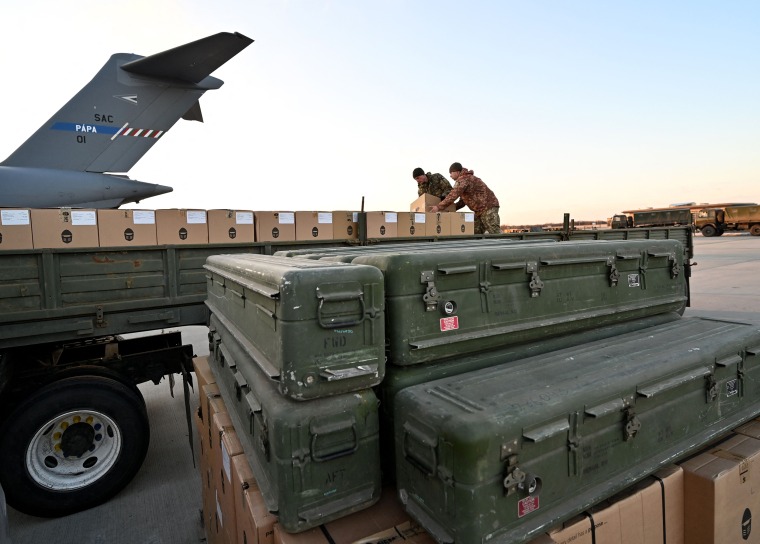WASHINGTON — Billions of dollars being spent by the federal government to arm Ukraine and replenish U.S. military stockpiles have been slow to translate into a significant number of new jobs in the U.S. as defense manufacturers grapple with logistical challenges in ramping up production.
Weapons manufacturers and Defense Department officials declined to say how many workers have been hired to help meet the increased demand, but comments by company executives and corporate filings indicate that the number of jobs has been relatively small compared to the overall size of the industry despite the flood of federal dollars.
More than a year and a half since Russia’s invasion of Ukraine, defense companies say they have been struggling to hire workers in a tight labor market, untangle supply chain snarls and restart mothballed production lines. While there are starting to be signs of progress, it could be several more years before production peaks and the billions of dollars earmarked for the war in Ukraine begins to impact the wider economy, industry analysts said.
“It takes time to surge,” said Cynthia Cook, director of the Defense-Industrial Initiatives Group at the Center for Strategic and International Studies, a bipartisan think tank. “The industrial base is incentivized to be as efficient as possible so that means there’s not a lot of manufacturing slack in the system, and that makes it challenging to grow.”
The U.S. has committed about $44 billion in direct security assistance for the war in Ukraine, the majority going to replenish U.S. stockpiles of ammunition, weapons and other equipment sent to the frontlines. President Joe Biden said last week he is seeking an additional $61.4 billion in aid for Ukraine and $14.3 billion for Israel.
Some Congressional Republicans have been fighting to prevent further spending on Ukraine, threatening to shut down the government to block additional assistance. In his pitch to voters last week for the money, Biden argued that it would provide a benefit at home as well as abroad.
“When we use the money allocated by Congress, we use it to replenish our own stores, our own stockpiles with new equipment, equipment that defends America and is made in America,” Biden said in the televised address from the Oval Office. “Patriot missiles for air defense batteries made in Arizona, artillery shells manufactured in 12 states across the country in Pennsylvania, Ohio, Texas, and so much more.”
But expanding production in those places is taking time. Some companies are having to restart manufacturing of weapons they haven’t made in years, requiring them to rehire workers and reassemble manufacturing lines. Others said they have struggled to find workers, particularly those who are able to get security clearances or willing to move to more remote areas where weapons production typically takes place. In some cases, new facilities need to be built, a process that can take several years to get through the planning, permitting and approval stages.
Because of the short-term horizon for certain types of defense spending, the U.S. has fallen into a cycle of surging then shuttering its defense manufacturing capabilities in recent decades, said William LaPlante, the under secretary of defense for acquisition and sustainment at the Defense Department, during a conference last month. As a result, it can take several years for companies to restart their manufacturing infrastructure when a conflict arises and demand surges, LaPlante said.
“If the government, with industry, focuses, you can get a lot done. You can ramp up production lines and we are,” said LaPlante. “But you get the industrial base that you resource, it’s that simple,”
RTX Corp., formerly known as Raytheon, has said that supply chain disruptions and difficulty hiring engineers, skilled laborers and security clearance holders along with high turnover and rising wages have hindered its ability to meet demand for its weapons, like those being used in the war in Ukraine.
“We have had difficulties procuring necessary materials, including raw materials, components, and other supplies, and services on a timely basis or at all. We have also had difficulties hiring qualified personnel, particularly personnel with specialized engineering experience and security clearances,” the company said in its earnings report released Oct. 24. “The timing as to when our supply chain and labor challenges will abate is uncertain and subject to a wide range of factors and future developments.”
The company told investors last spring that it would take more than a year to ramp up production of Stinger missiles, which have been prominent weapons in Ukraine because the U.S. hadn’t ordered a Stinger missile in about 18 years — leaving the company with a limited stock of materials and having to redesign some of the electronics to replace parts that were no longer available.
 U.S.-made FIM-92 Stinger missiles shipped to Kyiv in 2022.Sergei Supinski / AFP via Getty Images file
U.S.-made FIM-92 Stinger missiles shipped to Kyiv in 2022.Sergei Supinski / AFP via Getty Images file
“Increasing capacity is going to be difficult, and it’s going to take attention from the top over the long term to get it going,” said Cook. “Defense contractors are typically awarded contracts at a low cost basis so the most efficient contractor typically wins. That means there’s not a lot of manufacturing slack in the system, and that makes it challenging to grow.”
Raytheon CEO Greg Hayes told investors on its earnings call this week that it has been awarded $3 billion of orders related to replenishing U.S. stockpiles with equipment sent to Ukraine and it expects another $4 billion of orders in the next two years. But it will be 24 to 36 months before those contracts are delivered on.
“You won’t see a big revenue pop, even next year from this,” Hayes said.
Lockheed Martin said it has seen increased demand from the war in Ukraine for its products, including Javelin anti-tank missiles and High Mobility Artillery Rocket System launchers. But the company said the impact on its business will be felt over years, rather than months, and it doesn’t anticipate a significant increase in its 2023 sales given the “long-cycle nature of our business and current industry capacity.”
Across all of its units, Lockheed increased its workforce by 2,000 people in 2022, a less than 2% increase across the company. The company currently has 900 openings in its missile and fire control division, said a Lockheed spokesperson. In Camden, Arkansas where Lockheed manufactures missile systems used in Ukraine, the company has 40 job openings, the company said.
Orders at General Dynamics’ Combat Systems business unit — which makes tanks and munitions — were at their highest level in years, driven in part by growth in its vehicles and tank sales and programs to expand artillery production capacity for the U.S., the company has said.
A General Dynamics spokesperson said the company doesn’t track the jobs added directly related to Ukraine. Across the entire company, General Dynamics added 3,400 workers in 2022 to a total global workforce of 106,500. The company is in the process of building a new plant in Mesquite, Texas that would eventually employ 125 workers making artillery shell casings that have been in high demand since Russia invaded Ukraine.
“Typically, the first thing companies will do is have people work overtime, then they’ll add a shift,” said Brad Martin, director of the Institute for Supply Chain Security at the RAND Corporation. “But over the long term, we’re actually talking about building more factories that will be more or less in the same places that they’re made now, but all that has a pretty significant effect on the local economy eventually.”
Some of the greatest demand has been for ammunition with the Ukrainians firing thousands of rounds a day.
The Defense Department plans to spend $2 billion to increase production of weapons and ammunition being used in Ukraine at plants in Pennsylvania, Iowa, Tennessee and Virginia with funds that have come from the Ukraine supplemental funding packages, according to an Army spokesperson. The Army declined to say how many jobs those investments could create. At one ammunition plant in Middletown, Iowa, the website for the outside hiring agency lists 26 open positions.
Over the past year, the Defense Department has doubled production of 155 millimeter artillery shells used in large towed-guns and by 2025 it anticipates further tripling that production to 100,000 a month with the investments it is making at its facilities, said LaPlante.
Once that manufacturing does ramp up, it will remain a question of whether that production is sustained or if the U.S. enters another cycle of booms and busts.
“We still have some major limitations in the industrial base, mostly based on factory capacity. My sense is that that has not significantly improved, we are still up against the same kinds of challenges that we’ve been up against for the last several years,” said Martin. “I think there’s greater awareness, but it’s going to take time, and it’s going to take some persistent funding to really get us into a better place.”




